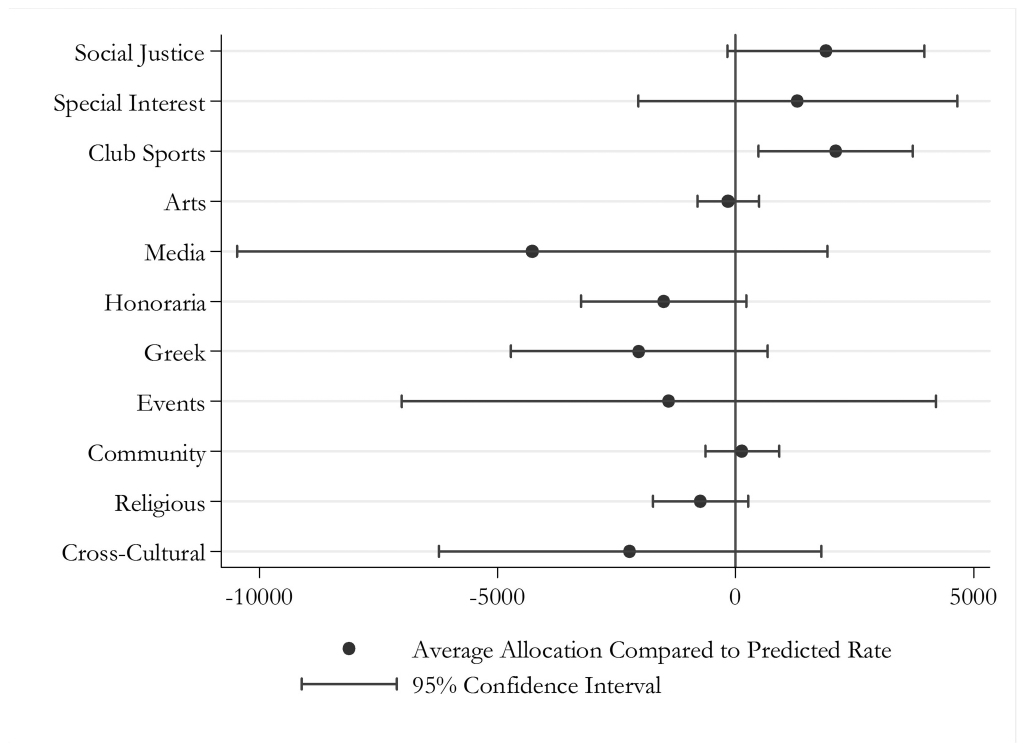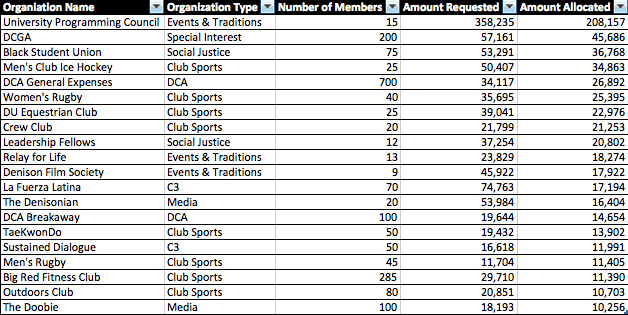By Jewell Porter
Editor-in-Chief
With $1.6 million requested and just $846,000 in student activity fees to be allocated to over 150 campus organizations, it is no surprise that there was so much campus controversy about the recent budget cuts. Students charged that the finance committee, headed by Ashley Bartreau ‘16, unfairly allocated student funds to some organizations over others.
In response to these allegations, President Meghan Pearce ‘16 gave a statement about the state of DCGA’s budget on April 9, which was followed by an open forum for members of DCGA, the finance committee and students interested in the finance process, although only twelve students — other than members of DCGA — attended.
Pearce and other members of the finance committee sat on the second floor of Slayter from 1:30-4:30 p.m. on April 8, prepared to answer any questions, comments or concerns that students had regarding their organizations’ budgets or the finance committee in general.
The money allocated by DCGA comes from the activity fees that students pay each year. $430 out of each student’s tuition goes toward student activity fees.
In addition to the money raised, DCGA also has a reserve fund of $378,000 that is left over from the Reserve Fund projects from last year. The money allocated to the Chamberlin Bar Proposal ($145,000) is currently frozen.
The organization that received the most funding was the University Programming Council, which got $208,157 (58 percent of what it requested). Next highest is DCGA, which gave itself almost 80 percent of what it requested, which is $45,686. The Black Student Union received the third-highest amount at $36,768, (69 percent of its request).
Only a handful of organizations received 100 percent of what they requested, including the Tennis Club ($2,379), Swimming ($1,029), Sigma Delta Pi ($600) and the Republican Club ($250).

This graph shows that club sports were more likely to receive the funding they asked for than other group types. (Graph courtesy of Paul Djupe)
There are several ways to analyze the claims that DCGA unfairly gave some organizations more funding than others. After careful analysis of each budget listed on OrgSync, club sports combined (23 club sports) received a total of $198,614 of student activity fees or, in other words, 24 percent of the $846,000 that was allocated. Eight of the 20 organizations that received the most funding were club sports.
A second way to talk about fairness of the Finance Committee allocations is to compare the allocation rates across group types. In the figure, we compare the allocations received by group types (combining all honoraria, all social justice groups, etc.) to the predicted rate (48 percent) adjusted for group size (this came from a regression model).
The group averages (the dots) thus show whether the group type was treated systematically different from the average group. The capped lines are 95 percent confidence intervals – for students or other members of the community to claim different treatment of groups, those intervals should not overlap with zero.
However, they do for all groups except for club sports. Club sports received a significantly higher allocation rate than the average group, which means that club sports were more likely to receive more student activity fees than any other group.
However, Pearce pointed out that club sports need a lot of money to simply function. The equestrian team, for example, needs to pay for its horseback riding lessons and registration fees in order to continue to exist on campus. She said, “Organizations like the equestrian and hockey teams need to have equipment in order to function. Some of those basic necessities of the organizations is a reason that they are more expensive.”
This club sport, led by Elizabeth Williams ‘16, received the seventh highest allocation with $22,976, which is about 59 percent of their requested budget. However, the money that they needed for their riding lessons and horse use was cut in half in their budget, with $13,375 going to riding lessons.
Williams said, “If we wanted to run [the club] the same way next year, then we would have to practice every other week rather than every week.” She pointed out that doing things like jumping fences could be dangerous for riders who don’t practice as often.
Sports teams were not the only top-funded organizations concerned about the future of their organization. The Black Student Union (BSU), for example, received $36,768 in student activity funds; however, their most important event, Culture Jam, which serves the whole campus, received less money than it needs to function as well.
With a budget cut of $16,000, President of the BSU Maya Washington-Ziegler said that the funds it was allocated will not be sufficient in funding this event, which has been put on by the BSU for the past 15 years.
Washington-Ziegler pointed out that Culture Jam is a week-long event and not just a concert at the end of the week. She said that $6,000 of the money allocated to Culture Jam will go just to receiving adequate speakers and the agent fee, so the organization will have $24,000 to bring a suitable performer to the event. To put this into context, she said, “Vic Mensa was $30,000, and I had never heard about him.”
Despite the fact that some organizations need a lot of funding to exist, some members of the Denison community expressed last week that they still feel that this allocation of funds is unjust because it takes away money that could be used for other campus organizations.
In response to this, Pearce suggested that members of the Denison community come together to decide what they want to fund with their student activity fees as a student body. During her address to the student body, Pearce said, “As a campus, we need to talk about what we prioritize.”
She later explained that “we have to have a continuous conversation. We cannot afford to have situations like last week happen again.” Pearce explained that if the “process isn’t working, [then] great, let’s fix it.”
The large amount of organizations on campus could explain the low amounts of funds that organizations received. Pearce said, “A lot of what is at the heart of the controversy right now is that we have too many organizations. There’s a lot of interest on this campus — that’s not a bad thing. That’s what makes this campus this campus. The difficulty is that when we don’t communicate with each other enough to know who we are, etc.”
Because there are more organizations, she said that the finance committee has “fewer resources to give out, and we cannot afford to have five different speakers of the same type come to Denison.”
This explains why Pearce and the finance committee encouraged organizations to collaborate. For example, the Denison Democrats and the Denison Republicans worked together to bring Joe Lieberman to campus, which was $36,492 in student activity fees.
Similarly, the BSU, Outlook, the Denison Feminists, UPC and SHARE collaborated to bring Laverne Cox, an actress best known for her role in Orange is the New Black, to campus ($32,822 in total).
All senators will vote to determine how to proceed with the appeals process today at the DCGA senate meeting. There are only $2,000 of funds that can be allocated to organizations.
DCGA will vote to decide on three options: 1) partially fund organizations with the $2,000 that was reserved for the appeals process in order to stay within the budget, 2) open the reserve fund to pay for the extra money that organizations need, which Pearce says could potentially create a deficit of student activity funds should DCGA vote next year to spend the money frozen for the Chamberlin Bar, or 3) amend the entire budget to pull from other organizations to fund those that requested appeals.

This table shows the 20 organizations that received the most funding from student activity fees. These 20 organizations received $388,938 of the $846,000 in student activities fees for the 2015-2016 school year. (Photo Courtesy of Jewell Porter)
Pearce encouraged all those interested in the appeals process to attend the DCGA meeting on April 14.
